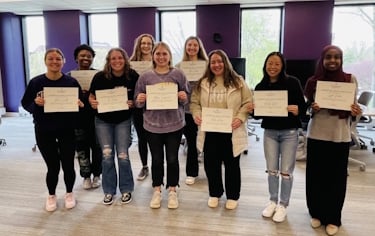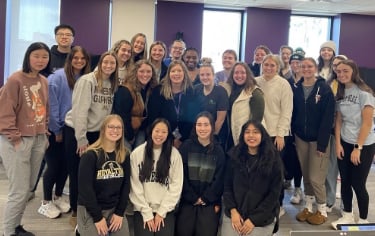Student Handbook, Placement Assessment, & Credit for Prior Learning


STUDENT HANDBOOK
Please view the American Sign Language Certificate Program section in the Student Handbook.
ASL Placement Assessment
The purpose of the American Sign Language (ASL) placement assessment is to determine an appropriate ASL course level for students to enroll by assessing your ASL skills receptively (watching) and expressively (signing).
Who Should Complete an ASL Placement Assessment
- You have taken ASL courses in high school or from another university or college institution.
- You wish to be exempt from CDIS 205 or be placed into CDIS 306 (Intermediate ASL – Level II) or higher (CDIS 307 Advanced I ASL - Level III or CDIS 407 Advanced II ASL - Level IV).
- You are a child of a Deaf Adult who uses ASL at home.
If you haven’t received ASL instruction in an educational setting, it is strongly recommended that you enroll in CDIS 205 (Beginning ASL – Level I). Students with little or no experience in ASL will automatically be placed in CDIS 205 and are not required to take an ASL placement assessment.
Steps
- The students completes this ASL Placement Assessement Form
- The ASL Coordinator will schedule a 30-minute placement assessment with you. This assessment will be scheduled at specific times throughout the academic year to accommodate and support the registration window.
- The following will be discussed during the assessment:
- The student’s previous and current ASL course curriculum info and guidelines
- Conversation Q & A
- The student completes in person or video assessment from the ASL curriculum
- The placement assessment is held in-person with the ASL Coordinator in Clinical Sciences Building 322 at MSU-Mankato.
- Once the placement assessment is complete, an appropriate ASL course is identified for the student.
Credit for Prior Learning
Academic credit awarded for demonstrated college and university-level learning gained through learning experiences outside of the college or university classroom, assessed by academically sound and rigorous processes.
Who Should Complete Credit for Prior Learning
Students who desire to be in a more advanced ASL course AND need to earn credit for a current or previous course. It is a common procedure after the ASL Placement Assessment Process is complete.
Steps
- Students make a request with current course instructor or ASL Coordinator. Credit will be awarded based on a method of prior learning demonstrated by the student.
- Exam will be considered final exam of intended course. The student is required to receive a B or a higher grade in order to earn credit for the previous course. Students need to pay for the exam ($50/credit. For example, a 3-credit course = $150)
- ASL Coordinator/ASL professor will assist the student to complete a Credit for Prior Learning Form.
MSU-Mankato ASL Coordinator Contact Info:
Kari Sween (she/her/hers). M.S. Assistant Professor kari.sween@mnsu.edu
Department of Speech, Hearing, and Rehabilitation Services
322 Clinical Sciences Building
Minnesota State University, Mankato

